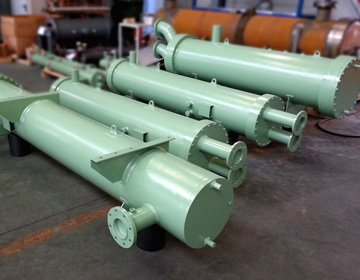How does a shell and tube heat exchanger work?
A shell and tube heat exchanger comprises of a cylindrical shell (outer vessel) with a bundle of tubes (inner vessels) running through it. The two liquid streams flow through isolated sections: one through the tubes (tube side) and the other around the outside of the tubes inside the shell (shell side). Let’s discuss about how does a shell and tube heat exchanger work?
Heat Transfer:
- Heat transfer happens through the dividers of the tubes, which act as a boundary between the two liquids. When the hot liquid flows through the tubes, it heats up the tube dividers. As a result, heat is exchanged from the hot liquid to the tube dividers by convection.
Thermal Conductivity:
- The heat conducted through the tube dividers then exchanges to the cold liquid flowing on the shell side. The cold liquid absorbs the heat from the tube dividers through convection, causing its temperature to increase.
Flow Patterns:
- The liquids may flow in different designs inside the heat exchanger, counting parallel flow, counterflow, or crossflow configurations. These flow designs impact the effectiveness of heat transfer and decide the ultimate temperatures of the liquids leaving the heat exchanger.
Enhancement Techniques:
- Turbulence-enhancing highlights such as baffles, tarbulators, and fins are frequently joined into the plan to advance way better blending and increment the heat transfer coefficient. This progresses the overall productivity of the heat exchanger.
Fluid Distribution:
- Proper distribution of the liquids entering the heat exchanger is basic to guarantee uniform flow and maximize heat transfer. Dispersion systems, such as channel headers and tube sheets, offer assistance equally disseminate the fluids over the heat exchange surfaces.
Heat Exchanger Efficiency:
- The effectiveness of a shell and tube heat exchanger depends on a few components, counting the flow rates and temperatures of the fluids, the surface area of the heat exchange surfaces, the plan of the heat exchanger, and the liquid properties.
Applications:
- Shell and tube heat exchangers are broadly utilized in different businesses, counting chemical preparing, petroleum refining, power generation, HVAC systems, and nourishment processing. They are reasonable for applications including heating, cooling, condensation, and evaporation processes.
Overall, shell and tube heat exchangers give an productive and dependable implies of transferring heat between fluid streams whereas maintaining their division, making them indispensable components in numerous industrial processes.

